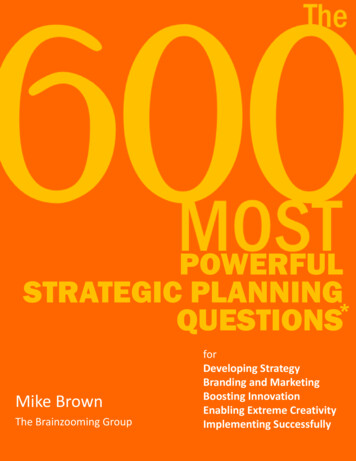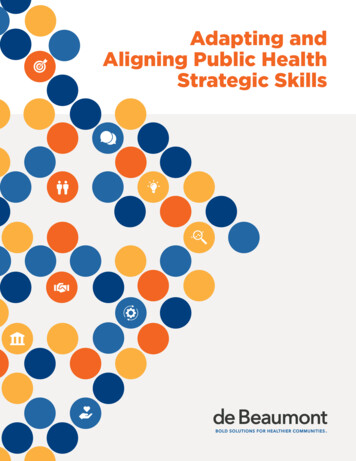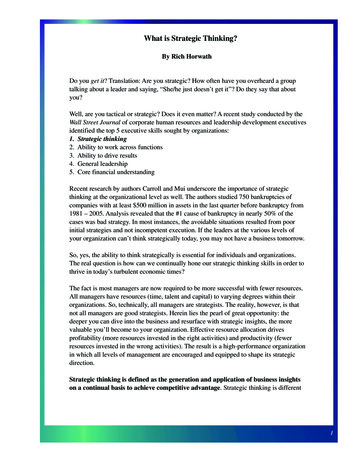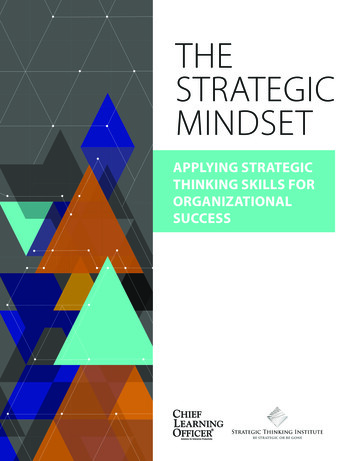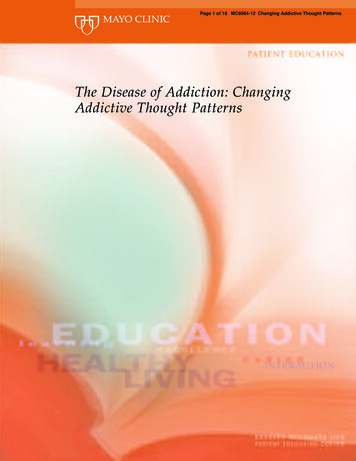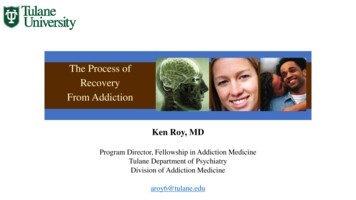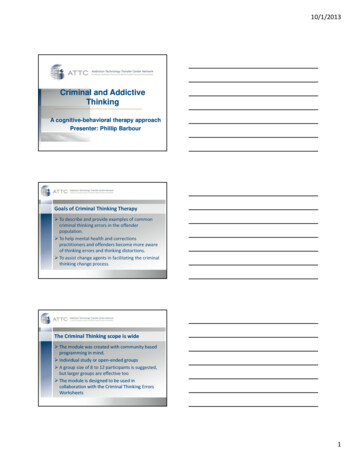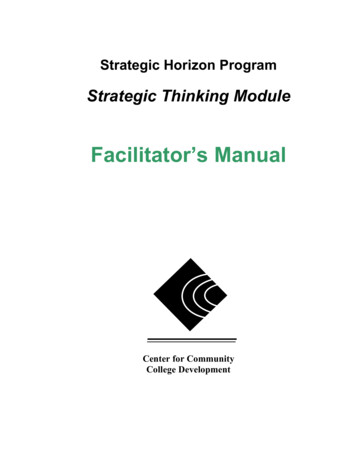
Transcription
Strategic Horizon ProgramStrategic Thinking ModuleFacilitator’s ManualCenter for CommunityCollege Development
Strategic Horizon ProgramStrategic Thinking ModuleFacilitator’s ManualBefore the Session[Facilitator: Prior to the training session for Strategic Thinking (ST) contact a representative of thecollege to determine the following: the number and types of staff for whom training is desiredthe objectives and desired outcomes of ST trainingthe order of training for different groups (a suggested sequence is senior administratorsfollowed by supervisors, faculty and classified staff)the size of the group(s) to be trained (the maximum number should not exceed 25)the composition of the groups to be trained (mixed groups, homogenous groups, etc.)seating arrangements for the training session(s)institutional preference for case study work or identification of “unmet opportunities” inthe closing segment of the training sessionif the preference is for “unmet opportunities”, discuss with the college representativea process or procedure for handling the opportunities that are identifiedthe institution’s preference for follow-up with staff after the training sessionThe packet for session participant should include: 1) a hard copy of the ST Powerpointpresentation, 2) copies of 2 newspaper articles (the hotel industry article and a recent national orlocal newspaper article), 3) worksheets for session exercises (case study worksheet or“unrealized opportunity” worksheets), and 4) the session evaluation form.2
Facilitating the SessionI. IntroductionSlide #1 Strategic Thinking moduleBefore we begin, let’s introduce ourselves—I’m and this is (if more than oneperson is conducting the session). . . (self-introductions continue) . . .Welcome to a learning experience on Strategic Thinking—what you will soon come to call “ST.” StrategicThinking will play an increasingly important role in the development of this college. It is all about theapproach to thought that you and your fellow faculty and staff use in your work. A capacity to moreintentionally use a “big picture approach” to thinking will enable you to know more about students andimportant stakeholders—what they think, what they want, what they expect, and more—and thereby toserve them better. For this reason, strategic thinking is your business. It is everyone’s business in thiscollege.Strategic Thinking is one of seven capabilities that colleges are committed to developing as part of theStrategic Horizon Program. The Program and the capabilities it is developing are described in thebrochure that you received several days ago. In case you did not have a chance to read it, another copyis at your table. To refresh your memory the seven capabilities eMapping/ChangeDevelopingLeaders[Facilitator: Pause to determine if the meeting participants are familiar with the Strategic HorizonProgram]II. The Strategic Thinking ModuleThe Strategic Thinking Module is a 2-3 hour training program to develop more intentional strategicthinking skills. It will begin with a definition of Strategic Thinking, a description of what it is designed toaccomplish, and the learning outcomes we want to achieve through this module. Next we will ask you tolook over a newspaper article and identify key themes. Then, we will examine key questions that arepart of a protocol for strategic thinking. Finally, we will close the first part of the session by revisitingthe newspaper article and reinterpreting it using the protocol of Strategic Thinking. After a short break,we will ask you to work through an assignment in which you identify and describe an unmet orunrealized opportunity, either within the college, your own department, or in your personal work. Youwill be asked to think through this opportunity using the protocol of strategic thinking. To carry out thisassignment, you will complete a page describing: 1) the nature of the opportunity, 2) how you used thecomponents of ST to analyze the opportunity, and 3) a plan or course of action to pursue the opportunity.[Facilitator: Pause at this point, ask if there are any questions, and answer them]3
III. Definition of Strategic ThinkingSlide #2 Definition of ST[Facilitator: Review the working definition of Strategic Thinking and elaborate on it using workingexamples from your experience.]Slide #3 What ST Accomplishes[Facilitator: Describe what can be accomplished by the individual through enhanced capability inST. Use examples to illustrate the points you are making and ask participants to provide personalexamples of how they think ST might help them.]IV. Purpose and Objectives of the ST ModuleFor community colleges to excel in the knowledge economy, people in all parts of the institution—faculty,administrators and support staff—need to be able to look at forces in the environment (trends, events,circumstances and information) and determine implications for the institution, their department or serviceunit, and their work. In short, we all need to be able to think strategically about the college and our areain it. Fortunately, there is a protocol for strategic thinking (ST) that can enable all of us to use it moreintentionally; that is, to more routinely and naturally use it in our work. This module is designed tointroduce us to this protocol and help us better understand the important role that strategic thinking playsin enabling us, our departments, and ultimately the college, to identify and pursue opportunity throughenvisioning what we may ordinarily overlook. It is not possible to pursue an opportunity that we cannotsee.[Facilitator: Provide a working example or use the example below:]For example, both nationally and in (the state in which the college is located),statistics on the number of men and women attending both community colleges, and colleges anduniversities in general, have shifted dramatically over the past decade: In September, USA Todayreported that 135 women now earn bachelor’s degrees for every 100 men--a complete reversal of paststatistics. And, this article is only the latest of several that have appeared in newspapers indicating areverse-gender gap in higher education. Yet, colleges have not yet begun to fully respond to this changeby providing mentoring systems and scholarships that specifically target men as an under-representedgroup in the way that we targeted women in past years.Clearly, the value of strategic thinking is realized through people who use it to discover new or previouslyunrecognized opportunities. The more frequently and the more intentionally it is used, the greater thebenefit to the college as we identify and pursue opportunities in all parts of the institution. At the personallevel, we sometimes tend to think that only top-level administrators, perhaps only the President alone,need to use strategic thinking. But the truth is that we can all use ST to good effect in a number of ways: To enhance the effectiveness of a department or unit on our students and stakeholders by betteranticipating their needs and expectations and by delivering better academic preparation andserviceTo help shape the future of the collegeTo achieve personal fulfillment by helping students reach important goalsAnd, finally, the ST skills that we develop can be used not only inside the college, but in mostaspects of daily life.4
[Facilitator: Provide three more examples showing how ST can be used: 1) at the institutionallevel, 2) at the department level, and 3) at the personal level applied to one’s work. An illustrationof how Tulsa Community College is doing this is provided below]For instance—at the institutional level, TCC has used demographic data showing that a significantpercentage of Native Americans are located in West Tulsa compared to other sections of the city, todevelop a program in Native American Studies on the West Campus.At the department level, Business faculty at the Western Campus have created an honors program byplanning an interdisciplinary sequence of courses that result in the creation of a virtual company. Thiscompany then allows honors students to practice strategic thinking as they plan and market theircompany. As a result, both the faculty and their students are developing Strategic Thinking skills at theindividual level that can be used in community service and in their personal lives.So, with this background and these examples in mind, here are the objectives we want to achieve todaywith Strategic Thinking. At the conclusion of this module we hope you will have an interest in and adesire to use the following skills:Slides #4 and #5 Desired learning Outcomes[Facilitator: Review the five learning outcomes that the module is designed to achieve as shown inSlides #4 and #5] a heightened interest in acquiring and analyzing information and an increased awareness oftrends conveyed in information and interactions with students, stakeholders, and collegeemployees. an ability to identify “big picture” themes in information delivered through various media, includingthe Internet, television and radio, newspapers and magazines, published reports, marketingmaterials, institutional research and college data--virtually anything that is written. You shouldalso be able to identify important themes from observation, experience, and information shared incasual conversation. a capacity to gauge and determine the implications (i.e. meaning, impact, or effect) of thisinformation for your institution, department or service unit, and your work. an ability to determine a course(s) of action that can be taken to: a) mitigate the undesirableeffects of a specific trend or circumstance identified in the media and other sources ofinformation, b) encourage the development of a positive trend, and c) pursue a new opportunitythat could potentially benefit the college, your department or service unit, and/or your work. a capacity to apply strategic thinking comfortably in all aspects of your work and to engage othersin the protocol and help them develop strategic thinking skills and competencies that can be usedin their work.V. Newspaper Exercise[Facilitator: Now, let’s have a little fun with ST:]Slide #6 Newspaper Exercise5
Hotels hope visitors check out livelier, upgraded lobbyBy Roger Yu, USA TODAYFebruary 13, 2006Hotel lobbies aren't just places to check in anymore.Flush with money from the travel boom, the U.S. hotel industry will spend 5 billion on improvements in2006, says consultant PricewaterhouseCoopers. Hotels are channeling much of it into lobbies, makingthem inviting places to meet, linger and mingle.They're betting that spiffier, livelier lobbies will give a competitive edge. And by drawing guests out oftheir rooms, hotels hope to generate more food and beverage sales: Marriott. Its new lobby plan calls for a lounge with intimate tables and wait service. For guests whowant to work but don't want to be cooped up in their rooms, the plan — partly inspired by Starbucks andairlines' airport clubs — lays out an area of alcoves. Marriott will start with newly constructed andrenovated hotels, and eventually incorporate the model throughout the chain. "It's about public privacy,"says executive Mike Jannini. Embassy Suites. The Hilton-owned chain, known for open-air atriums, said last month it will startinstalling "a European-style" cafe in its hotels. To enlarge the usable space, it will eliminate the front deskand replace it with a set of self-check-in kiosks and podiums manned by staffers. Sheraton. In partnership with Web portal Yahoo, Sheraton said in January that it will test a Wi-Fienabled communal lobby lounge at some of its hotels, including The Sheraton San Diego. It featuresdesktop computers, a plasma TV, food and comfortable chairs. Boutiques. The high-end Kimpton chain spent more than 300,000 on lobby furniture when it openedHotel Solamar San Diego last July.Langham Hotel Boston, owned by Hong Kong-based Langham Hotels, will enlarge the lobby and movethe bar and restaurant down from the second floor. The goal is to make the hotel, once home to theFederal Reserve Bank of Boston, more contemporary and lively, manager Serge Denis says.W Hotels kicked off the lobby competition in the late 1990s with its first hotel, which is in New York. Itslobbies, known for buzzing parties, sleek décor and mood lighting, got inspiration from European hotelsand cafes, says executive Ross Klein.Anne Seymour, a Washington, D.C.-based crime victims' advocate, says she is finding it increasinglyconvenient to have meetings in hotel lobbies. Says Seymour: "They are larger, cleaner and (have) hugefluffy couches, free magazines and newspapers. Geez, who needs to even get a room anymore?"6
We are distributing two newspaper articles, one focusing on the hotel industry and the other a recentarticle from a national or local newspaper. Working individually, you are asked to read both articles,identify the key theme(s) in each, and write them down.1. Next, work as a group, selecting one person at your table to write down the consensus of thegroup in answering the following questions: What is/are the key theme(s) in each article, as determined by the group?Working individually, did most members of the group find the same theme or did they identifydifferent themes?What makes this theme stand out? Why is it significant?3. Afterward, we’ll share responses from each table.[Facilitator:Give the participants 15-20 minutes to review the articlesEngage the participants in intensive discussion relative to these questions andrecord their answers for each article on newsprint.Synthesize and summarize for the participants their overall reaction to the article-and confirm thatyour summary accurately represents their thoughts.]VI. Protocol for Strategic ThinkingUsing the newspaper articles as a frame of reference, let’s look at the questions that need to be askedand answered when we are “thinking strategically” about community colleges. These questions are:Slide #7 Strategic Thinking/ A Question-based Protocol[Facilitator: Walk the participants through the ST questions and show how different conceptionsof the information in the newspaper articles can be achieved by asking and answering thequestions that are part of the protocol. Demonstrate the analysis leading to a differentinterpretation of the article on a question-by-question basis rather than waiting to the end of theprotocol.]Slide # 8 A Question-based Protocol (cont.)1. Define the enterprise– What “business” is the institution in?– Is the business attractive?2.Identify the stakeholders– Who are the key stakeholders?– What are their characteristics and needs?– What do they want—today? Tomorrow7
Slide # 9 A Question-based Protocol (cont.)3. Identify the value created– What value is the institution delivering to key stakeholders?4. Analyze the environment– What forces are at work or emerging in the external environment?– Who are the competitors, what are they doing, and what are they apt to do?Slide #10 A Question-based Protocol (cont.)5. Determine the source(s) of advantage– Does the value created differentiate the institution from competitors?– What “new form(s)” of value can be created to achieve an advantage overcompetitors?– Is the advantage sustainable?Slide #11 A Question-based Protocol (cont.)6. Assess Capabilities– What are our institution’s strengths and competencies?– What are its resources?– What competencies and resources does it need to develop or acquire to build anadvantage?Slide #12 A Question-based Protocol (cont.)7. Assess Implications-- What are the implications of these responses:For the college?For your department?For you in your work?VII. Summarize[Facilitator: Summarize the questions that need to be asked and answered in the StrategicThinking protocol using Slide #13. As part of this summary, demonstrate the importance ofstrategic thinking by asking participants to: a) answer each question in the protocol for the hotelindustry and also for community colleges and b) compare these answers to the themes theyidentified after reading the articles.[The facilitator will close this phase of the Workshop by asking the participants Slide #14 whatthey have learned about ST so far and what personal value it may have for them in their work.]Refreshment Break8
[Facilitator: Following the break you will have a choice as to the design and length of the secondand final phase of the session. Your options are:1) limit this phase to one activity by asking participants to identify and flesh out an “UnrealizedOpportunity” using the ST protocol or2) engage the participants more deeply in ST by asking them to work with a case study (providedby the facilitator) using the ST protocol.The choice of which option to use will depend on local institution preferences regarding desirablelength of the session, the makeup and time constraints of the participant group, and desiredoutcome(s) of ST training.If a choice is made to go with Option #1, the format will work as follows:VIII. Option # 1/ Identifying an Unrealized OpportunityFacilitator: Embedded in the newspaper articles were theme(s) involving conditions in the environmentthat, when fully understood and comprehended, could have a dramatic impact on this college, yourdepartment and, very likely, your work. While comprehending impact is important, just as important is thechance to identify and pursue an opportunity for your college, your department, or your work that hasbeen missed or overlooked.So now, we want you to work at your table—individually or in a group of your choice—and use StrategicThinking to identify an unmet opportunity in your college, your department, or your work. Please do thefollowing:[Facilitator: Bring up Slide #15 which describes the assignment related to Identifying anOpportunity] Describe the opportunity in one paragraph, thenAnalyze the opportunity using the questions in the ST protocol, andDevelop a course of action to pursue the opportunityPlease use the following pages to describe the opportunity and to chart your analysis of it using the STprotocol.[Facilitator: Bring up Slides #16 and 17 which provide participants with a worksheet forIdentifying an Opportunity]9
Slide #16Identifying an Unrealized Opportunity1. Describe the opportunity:2. Analyze the opportunity using questions in the ST protocol:(please use a separate piece of paper)Identify the stakeholdersWho are the key stakeholders?What are their characteristics and needs?What do they want—today? tomorrow?Define the value createdWhat value could be delivered to important stakeholders by pursuing this opportunity?Analyze the environmentWhat forces are at work or emerging in the environment that relate to this opportunity?Who are the competitors and what are they doing or what could they do?10
Slide #17Identify sources of advantageWill the value created through this opportunity differentiate our college, my department,or my work from that of competitors?Is the advantage obtained through differentiation sustainable?Assess capabilitiesWhat capabilities are in place in the institution, in my department, and through my workto pursue this opportunity?What resources are available to pursue this opportunity?What capabilities and resources need to be developed or acquired to successfullypursue this opportunity?Assess implicationsWhat are the implications of these responses for actions that need to be taken to pursuethe opportunity:For the college?For my department?For my work?3. Outline a plan of action you will use to pursue the opportunityYour name:Department: Position11
If a choice is made to go with Option #2, the format will work as follows:IX. Option #2/ Case Study[Facilitator: Distribute the case study and distribute a hardcopy of page 13 in this manual posingstrategic thinking questions. Then:1. ask the participants to use the ST questions on page 13 to analyze and solve the casestudy through small group discussion2. when the participants have finished, move around the tables and ask them to describetheir analysis and response to the case studyThere are choices available to you regarding what case study to use. The case study that followshas been developed and is being used by Tulsa Community College. It is provided here forillustrative purposes only. In the role of facilitator, you should plan to work with College officialsto identify a case study that will be meaningful to the participants.]Case StudyYou have just been hired as part of the leadership team creating a new proprietary college that willoperate in (your city or region). College of the Future plans to offer two-year associate degrees providingopportunities for transfer to senior level, bachelor’s degree granting institutions; one-year certificates andtwo-year associate degrees in a variety of occupational program areas and to provide extensive, noncredit workforce development training serving the needs of the community.College of the Future is part of an emerging national, for-profit organization that has been highly effectivein a variety of markets historically served by community colleges that consider themselves to be vibrant,responsive organizations. In entering a new market such as (your city/ region), the college closelystudies the operations of the local community college to look for opportunities allowing them to be moreresponsive to student needs than the existing institution. By following this model, they have been highlyeffective in recruiting students who may have ordinarily attended the community college, even though theexpense of attending the proprietary college is substantially greater. The online website for College of theFuture lists the following features:FlexibleFollowing a traditional academic calendar forces motivated adult learners to progress at a much slowerpace than you desire. Achieving your educational goals is confined to being a distant dream. At ourcollege, your educational goals become a quick reality. We recognize that your maturity and professionalsuccess will allow you to achieve your dreams at an accelerated rate. Classes are structured to enhancethe learning of new material and at the same time build upon previous experience of the adult learner.Often adults are able to move through their course work and achieve their degree in half the time of atraditional program.CollaborativeYou will become part of a small supportive team of adult learners who will stick with you throughout yourprogram to help you meet your educational goals. Our faculty are facilitators, rather than lecturers, andthey know that adults learn best in an interactive format with heavy emphasis on the practical applicationof their learning. In your class, you will gain from the rich experiences of other adult learners. This type ofcollaborative learning leads to graduation rates that are much higher than other schools.12
FacultyHere you will find experienced professionals whose academic qualifications and workplace experiencesequip them to provide each adult learner with a stimulating learning environment. Your faculty's personalexperience plus the students' varied work backgrounds create a rich learning environment. You willencounter course materials and class discussions where what you learn can be applied the next day.Your critical thinking and decision-making skills will also be enhanced as you apply course material toreal-world examples.Financial aidThe financial aid and accounting staff are ready to assist you. Online applications and the attentivesupport of the staff will aid you in obtaining a maximum award and meeting established deadlines. Coursework meets U.S. Department of Education guidelines and, based upon your income level, you may beeligible for State and Federal grants. We also offer an interest-free deferred payment up to 30 days afterthe course is completed.Library servicesUsing the power of the internet, the helpful staff of the Off-Campus Library Service bring a wealth ofresources right to your finger tips. While many enjoy the experience of visiting the library and sortingthrough the volumes of books and resources that are available, we are able to make those resourcesavailable to the busy adult student from the convenience of your very own home. An extensive network oftextbooks, journals, professional publications, databases, and electronic resources are available to you soyour research needs are met in an efficient and timely manner. The experience of the staff assists you infinding and assessing information from the resources of the World Wide Web.RegistrationPrior to starting your degree work, you will receive a class calendar that shows you the dates for all of thecourses in your core program. You don't have to worry that a course you need for your degree programwon't be available when you need it because all of the courses in your program are mapped out for you insequence. Waiting in long lines and registering for courses every semester are a thing of the past with ouradult degree programs.LocationsOur commitment to making college attendance for working adults convenient is a major reason why wehave become one of the fastest growing universities in the nation. We have created an easy systemwhere students do not have to leave their local community and travel hours to earn a college degree. Thisis why our college now has over 90 locations in Oklahoma, Kansas, Texas, Missouri, and Arkansas. Withmany locations and online programs, we bring the classroom to you!TextbooksAs a busy adult, you don't have time to purchase textbooks at a bookstore. COF delivers textbooks andcourse materials directly to you. We take the hassle out of purchasing textbooks by delivering the booksdirectly to you.13
Analyzing the Case Study Using theStrategic Thinking ProtocolAs a new member of the COF leadership team, think strategically about how you will develop COF inTulsa by answering the questions below:1. Define the enterprise:What ‘business’ is College of the Future in?Is the business attractive?2. Identify the Stakeholders:Who are the stakeholders of COF?What are their characteristics and needs?What do they want—today? tomorrow?3. Identify the value createdWhat value will COF need to deliver to students to be successful?4. Analyze the environmentWhat forces are at work or emerging in the external environment?Who are the competitors of COF? What are they doing and what are they apt to do?5. Identify sources of advantageWill the value created differentiate COF from competitors?What “new form(s)” of value can COF create to achieve an advantage overcompetitors?Is the advantage sustainable?6. Assess capabilitiesWhat are its resources?What competencies and resources does it need to develop as a source ofexcellence in higher education?7. Assess ImplicationsWhat are the implications of the above responses for your department at COF?What are the implications for you as an individual working at COF?14
Closing the SessionX. Next Steps[Facilitator: Bring up Slide # 18 on the screen]On each campus, we will need to lay a solid groundwork for ST to successfully develop as a regularcollege-wide practice. A good foundation may require three phases: acclimating the leadership team;identifying the level and groups to train; and conducting the training.First, assess whether change will need to occur before your managers will be receptive to staff at lowerlevels when they begin to offer strategic ideas and suggestions. Next, identify areas of the organizationthat you intend to train and plan a cascade approach in which the first group trained, in turn, facilitates thetraining of the next group, and so on, until all target groups have been trained. Also, decide whether totrain groups that are homogenous (comprised only of department heads or classified staff or faculty) orgroups that represent a variety of organizational levels and positions. Then the actual training can begin!Once multiple groups have been trained, we can use ST regularly in a variety of ways. As an example,Tulsa Community College recently developed a core values statement and revised its mission statement.Now it plans to use the ST process to revise its strategic vision statement. Your college might want to usethe ST process to set departmental goals or to engage a segment of the college—such as classified staffor academic support staff—in ST for the first time, to change the organizational culture. There are manypossibilities to be discovered, once we begin to use ST to recognize unrealized opportunities.[Facilitator: Thank the participants for coming, pass out the evaluation sheet, and ask them tocomplete it.]15
Selected ReadingsAlfred, R. (2001). Strategic Thinking: The Untapped Resource for Leaders. Community College Journal.71(3), 24-28.Cramer, J. (2002, February 1). Are You Thinking Strategically? Issues.http://www.di.net/article.php?article id 62Linkow, P. (1999). What Gifted Strategic Thinkers Do. Training and Development. 53(7), 34-37.Porter, M. (1987, May 23). The State of Strategic Thinking. The Economist, 303(7499). 17-20.Wilson, I. (1995). Envisioning (and Inventing) the Future. On the Horizon, 3(3), 1-5.Wilson, I. (1996). The Practical Power of Vision. On the Horizon. 4(2), 1-5.Wilson, W. (1997). Focusing Our organizations on the Future: Turning Intelligence into Action.On the Horizon. 5(3), 1-6.Selected ink lhttp://www.qm2.org/mbriefs/brief30216st.html16
EvaluationAs we wrap up the session on Strategic Thinking, we would appreciate feedback that willhelp us improve the module. Please take a few minutes to answer the questions belowand simply leave it for us. Thank you!What worked wel
The Strategic Thinking Module is a 2-3 hour training program to develop more intentional strategic thinking skills. It will begin with a definition of Strategic Thinking, a description of what it is designed to accomplish, and the learning outcomes we want to achieve through this module. Next
